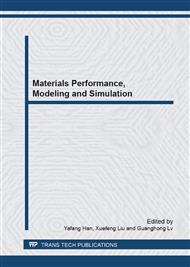[1]
M. Ishiyama, Plasma activated sintering (PAS) system, in: Y. Bando, K. Kosuge (Ed. ), Proceedings of the 1993 Powder Metall. World Congress, Kyoto, Jpn. Soc. Powder & Powder Metall. Jpn., 1993, pp.931-934.
Google Scholar
[2]
M. Frei, U. Anselmi-Tamburini, Current effects on neck growth in the sintering of copper spheres to copper plates by the pulsed electric current method, J. Appl. Phys. 101 (2007) 114914.
DOI: 10.1063/1.2743885
Google Scholar
[3]
K. Itatani, K. Tsuchiya, Y. Sakka et al., Superplastic deformation of hydroxyapatite ceramics with B2O3 or Na2O addition fabricated by pulse current pressure sintering, J. Eur. Ceram. Soc. 31 (2011) 2641-2648.
DOI: 10.1016/j.jeurceramsoc.2011.01.014
Google Scholar
[4]
Y.C. Wang, Z.Y. Fu, Study of temperature field in spark plasma sintering, Mater. Sci. Eng. B. 90 (2002) 34-37.
Google Scholar
[5]
M. Tokita, Trends in advanced SPS (spark plasma sintering) systems and technology, J. Soc. Powder Technol. Jpn. 30 (1993) 790-804.
Google Scholar
[6]
R. Chaim, R. Reshef, G. Liu, Z. Shen, Low-temperature spark plasma sintering of NiO nanoparticles, Mater. Sci. Eng. A 528 (2011) 2936-2940.
DOI: 10.1016/j.msea.2010.11.050
Google Scholar
[7]
Y. Watanabe, Y. Iwasa, H. Sato, A. Teramoto, et al., Microstructures and mechanical properties of titanium/biodegradable-polymer FGM for bone tissue fabricated by spark plasma sintering method, J. Mater. Process. Technol. 211 (2011) 1919-(1926).
DOI: 10.1016/j.jmatprotec.2011.05.024
Google Scholar
[8]
R.K. Chintapallia, E. Jimenez-Piquea, et al., Spherical instrumented indentation of porous nanocrystalline zirconia, J. Eur. Ceram. Soc. 32 (2012) 123-132.
Google Scholar
[9]
G.Q. Xie, H. Kimura, D.V. Louzguine-Luzgin, et al., SiC dispersed Fe-based glassy composite cores produce d by spark plasma sintering and their high frequency magnetic properties, Intermetallics. 20 (2012) 76-81.
DOI: 10.1016/j.intermet.2011.08.023
Google Scholar
[10]
S.X. Wang, S.L. Li, M.G. Wang, et al., Construction of 3D micro-cellular structure of the metal /ceramic system, Rare metals. 30 (2011) 604.
DOI: 10.1007/s12598-011-0355-z
Google Scholar
[11]
Z.K. Zhao, K.F. Yao, J.F. Li, A bulk metal/ceramic composite material with a cellar structure, Chin. Sci. Bull. 51 (2006) 235-239.
DOI: 10.1007/s11434-004-0491-9
Google Scholar
[12]
M. Tokita, Development of large-size ceramic/metal bulk FGM fabricated by spark plasma sintering, Mater. Sci. Forum. 308-311 (1999) 83-88.
DOI: 10.4028/www.scientific.net/msf.308-311.83
Google Scholar
[13]
T. Nagae, M. Yokota, M. Nose, et al., Effects of pluse current on an aluminum power oxide layer during pulse current pressure Sintering, Mater. Trans. 43 (2002) 1390-1397.
DOI: 10.2320/matertrans.43.1390
Google Scholar
[14]
M. Belmonte, M.I. Osendi, P. Miranzo, Modeling the effect of pulsing on the spark plasma sintering of silicon nitride materials, Scripta Mater. 65 (2011) 273-276.
DOI: 10.1016/j.scriptamat.2011.04.029
Google Scholar
[15]
S.W. Wang, L.D. Chen, Y.S. Kang, M. Niino, et al., Effect of plasma activated sintering (PAS) parameters ondensification of copper powder, Mater. Res. Bull. 35 (2000) 619-628.
DOI: 10.1016/s0025-5408(00)00246-4
Google Scholar
[16]
Z.K. Zhao, J.C. Li, Q. Jiang, Effect of sintering temperatures on the room temperature properties of Al90Mn8Ce2 alloys, J. Mater. Eng. Perform. 11 (2002) 262-264.
Google Scholar
[17]
N.A. Lange, J.A. Dean, Lange's Handbook of Chemistry, thirteenth ed., Mc Graw-Hill, New York, (1985).
Google Scholar
[18]
R. Pazhani, H. Padma Kumar, A. Varghese, et al., Synthesis, vacuum sintering and dielectric characterization of zirconia (t-ZrO2) nanopowder, J. Alloys Compd. 509 (2011) 6819–6823.
DOI: 10.1016/j.jallcom.2011.03.089
Google Scholar
[19]
D. Zhang, M.G. Wang and Z.K. Zhao, The performance and spark plasma assembling of ZrO2/Al90Mn9Ce1 core-shell structural micro-nano composite powders, Mater. Sci. Tech. 19 (2011) 209-213.
Google Scholar
[20]
R. Benato, A. Paolucci, Multiconductor cell analysis of skin effect in Milliken type cables, Electr. Pow. Systems Research. 90 (2012) 99–106.
DOI: 10.1016/j.epsr.2012.04.006
Google Scholar
[21]
K.A. Khor, L.G. Yu, O. Andersen, et al., Effect of spark plasma sintering (SPS) on the microstructure and mechanical properties of randomly packed hollow sphere (RHS) cell wall, Mater. Sci. Eng. B. 356 (2003) 130-135.
DOI: 10.1016/s0921-5093(03)00111-4
Google Scholar


